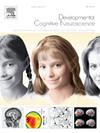Maternal depressive symptoms in childhood and offspring brain cortical and subcortical volumetric change: A repeated imaging study from age 4–10 years
IF 4.9
2区 医学
Q1 NEUROSCIENCES
引用次数: 0
Abstract
Maternal depressive symptoms have been associated with offspring’s brain structural differences. However, previous studies were limited by cross-sectional designs, brain region-of-interest analyses, or clinical samples. Importantly, few studies assessed the early childhood brain. This study analyzed data from a Singaporean cohort of 217 children with 589 repeated structural neuroimaging from 4.5 to 10.5 years (2–4 assessments) in relation to maternal depressive symptoms. Maternal depressive symptoms were measured by questionnaire at child age 4.5 years. Mixed models explored within-sample change accounting for non-linear brain development. Multiple testing was corrected, and a stringent threshold was applied. Maternal depressive symptoms were associated with persistently smaller precentral gyral volume over time (β = −0.162 [-0.238; −0.086], padj < 0.001). In analysis with time interaction, maternal symptoms were associated with curvilinear changes in the volumes of supramarginal (β = −0.019 [-0.027; −0.010], padj < 0.001) and precuneus gyrus (β = −0.016 [-0.025; −0.007], padj = 0.007); this suggests delayed volumetric development in brain areas governing attention, memory, and language among children exposed to severe maternal symptoms. The findings implicate that childhood maternal depressive symptoms are associated with persistent differences in precentral volume and affect the brain volumetric development of complex sensory information processing regions, rather than in emotion regulation areas implicated in the depression experience. Our findings emphasize repeated childhood imaging to understand child brain development risk factors.
母亲抑郁症状在儿童和后代大脑皮层和皮层下体积变化:一项4-10岁的重复成像研究
母亲的抑郁症状与后代的大脑结构差异有关。然而,先前的研究受到横断面设计、大脑兴趣区分析或临床样本的限制。重要的是,很少有研究评估儿童早期的大脑。本研究分析了来自新加坡的217名儿童的数据,这些儿童在4.5至10.5岁(2-4次评估)期间进行了589次重复结构神经影像学检查,与母亲抑郁症状有关。在儿童4.5岁时采用问卷调查的方法测量母亲抑郁症状。混合模型探讨了样本内变化对非线性大脑发育的影响。修正了多重检验,并应用了严格的阈值。随着时间的推移,母亲抑郁症状与中枢前回体积持续变小有关(β = - 0.162 [-0.238;−0.086],padj <;0.001)。在时间交互作用分析中,母体症状与子宫边缘上体积的曲线变化相关(β = - 0.019 [-0.027;−0.010],padj <;0.001)和楔前叶回(β = - 0.016 [-0.025;−0.007],padj = 0.007);这表明,在暴露于严重母亲症状的儿童中,控制注意力、记忆和语言的大脑区域的体积发育延迟。研究结果表明,儿童母亲抑郁症状与中枢前体积的持续差异有关,并影响复杂感觉信息处理区域的大脑体积发育,而不是与抑郁经历有关的情绪调节区域。我们的研究结果强调重复儿童成像以了解儿童大脑发育的危险因素。
本文章由计算机程序翻译,如有差异,请以英文原文为准。
求助全文
约1分钟内获得全文
求助全文
来源期刊

Developmental Cognitive Neuroscience
NEUROSCIENCES-
CiteScore
7.60
自引率
10.60%
发文量
124
审稿时长
6-12 weeks
期刊介绍:
The journal publishes theoretical and research papers on cognitive brain development, from infancy through childhood and adolescence and into adulthood. It covers neurocognitive development and neurocognitive processing in both typical and atypical development, including social and affective aspects. Appropriate methodologies for the journal include, but are not limited to, functional neuroimaging (fMRI and MEG), electrophysiology (EEG and ERP), NIRS and transcranial magnetic stimulation, as well as other basic neuroscience approaches using cellular and animal models that directly address cognitive brain development, patient studies, case studies, post-mortem studies and pharmacological studies.
 求助内容:
求助内容: 应助结果提醒方式:
应助结果提醒方式:


